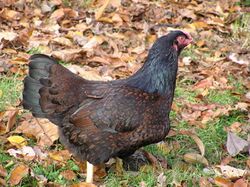Biology:Cornish chicken
The Cornish or Indian Game is a breed of chicken from the county of Cornwall in England . Cornish chickens, as well as crosses of Cornishes, are the most-used breed in the chicken meat industry.[1] They are heavy, muscular birds that lay brown eggs.
Name
The Cornish is known variously as Indian Game or Cornish Game depending on country. In America it was always known as Indian Game until 1905 when the American Poultry Association passed a motion to rename it Cornish Indian Game. Due to confusion caused by implying the breed came from India, and unpopularity of Game in the name, it was renamed to simply the Cornish in 1910.[2]
In Australia they are still known solely as Indian Game.[3] Usage of the two varies in the United Kingdom, but it is officially the Indian Game according to the Poultry Club of Great Britain.[4]
History
The breed was developed by Sir Walter Gilbert, 1st Baronet around 1820. It was accepted by the American Poultry Association in 1893.[2]
Description
It is a large, stocky breed, and is often crossed with other breeds to enhance meat production. There are two variates, the Cornish Game and the Jubilee Cornish Game. The Cornish Game is dark blue-green with brown patterning on the hens in there are also double laced of the above colors and a double laced blue in the UK and Europe. Jubilee Cornish Game tend to be lighter and less stocky than their counterparts. They are usually light wheaten in color, with light brown patterning.[citation needed]
It is quite a popular show bird. It has a tendency for bad legs due to widely spaced hips, although its domestic counterparts do not tend to have this issue and have a more standard posture and gait. It has a large breast and makes an excellent meat bird.[5] It is also when crossed with a Sussex, Dorking or similar utility type breeds. On average Indian Game produce 160–180 eggs per annum, less than some more prolific breeders.[citation needed] However, they are relatively easy to handle and make good mothers.[6] Indian Game require more space than most other breeds so they may not be suitable for suburban producers or enthusiasts. The Indian Game is highly prone to parasites. The Cornish must also be provided with extra shelter as their feathers tend to be thinner than other birds.[7]
Weight
| Cock | 3.86 kg | 10 lbs |
| Hen | 2.57 kg | 5.7 lbs |
| Cockerel | >1 kg | >2.2 lbs |
| Pullet | >1 kg | >2.2 lbs |
| Rooster | 2.0 kg | 4.4 lbs |
| Hen | 1.5 kg | 3.3 lbs |
See also
- Cornish-Rock
- Cornish game hen
- Delayed feathering in chickens
Notes
- ↑ [Keeping Chickens Guide . Accessed Jan 21, 2010.
- ↑ 2.0 2.1 "Cornish Chicken". The American Livestock Breed Conservancy. http://albc-usa.org/cpl/cornish.html. Retrieved 1 August 2014.
- ↑ Australian Poultry Standards (2nd ed.). Poultry Stud Breeders and Exhibitors Victoria. p. 196.
- ↑ "Indian Game". Poultry Club of Great Britain. https://www.poultryclub.org/breeds/chickens/hard-feather/indian-game/. Retrieved 8 June 2019.
- ↑ Aschwanden, Christie. (2011). Beautiful chickens. Perris, Andrew.. London: Frances Lincoln. ISBN 978-0-7112-3192-4. OCLC 751582016.
- ↑ Aschwanden, Christie. (2011). Beautiful chickens. Perris, Andrew.. London: Frances Lincoln. ISBN 978-0-7112-3192-4. OCLC 751582016.
- ↑ Aschwanden, Christie. (2011). Beautiful chickens. Perris, Andrew.. London: Frances Lincoln. ISBN 978-0-7112-3192-4. OCLC 751582016.
References
- Ekarius, Carol (2007). Storey's Illustrated Guide to Poultry Breeds. 210 MAS MoCA Way, North Adams MA 01247: Storey Publishing. ISBN 978-1-58017-667-5.
- Aschwanden, Christie (2011). Beautiful Chickens. 210 High Street, Lewes, East Sussex BN7 2NS UK: Ivy Press. ISBN 978-0-7112-3192-4.
External links


